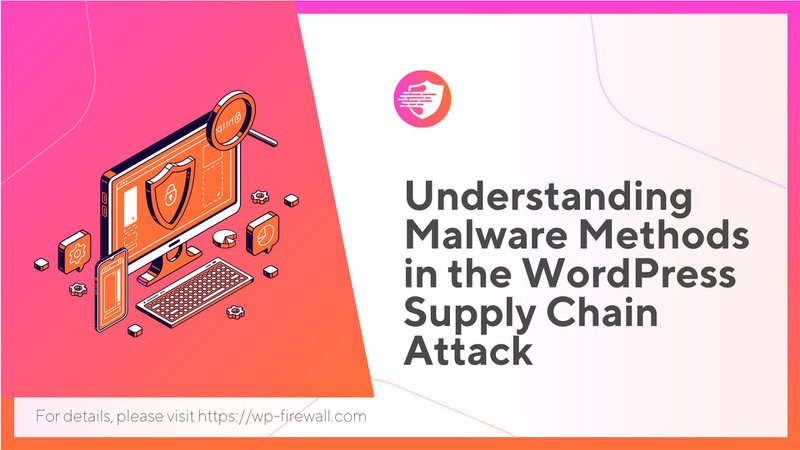
Cuộc tấn công chuỗi cung ứng gần đây vào WordPress.org đã gây chấn động cộng đồng bảo mật kỹ thuật số, làm nổi bật các lỗ hổng nghiêm trọng đòi hỏi sự chú ý của chúng ta. Blog này đi sâu vào sự phức tạp của cuộc tấn công này, xem xét phần mềm độc hại và các kỹ thuật mà thủ phạm sử dụng, đồng thời cung cấp thông tin chi tiết có thể thực hiện được về cách củng cố môi trường WordPress của bạn chống lại các mối đe dọa tinh vi như vậy.
1. Tổng quan chi tiết về cuộc tấn công chuỗi cung ứng
Cuộc tấn công chuỗi cung ứng WordPress.org là lời nhắc nhở rõ ràng về bản chất đang phát triển của các mối đe dọa an ninh mạng. Trong sự cố này, những kẻ tấn công đã nhắm vào cơ sở hạ tầng WordPress.org, đưa mã độc vào các plugin và chủ đề được phân phối thông qua kho lưu trữ chính thức. Mã độc này, sau khi được cài đặt trên trang web của người dùng, cho phép kẻ tấn công truy cập trái phép, đánh cắp thông tin nhạy cảm và có khả năng làm gián đoạn hoạt động của trang web.
Sự phức tạp của cuộc tấn công này nằm ở sự tinh vi và tinh vi của nó. Những kẻ tấn công không chỉ nhắm vào các plugin và chủ đề được sử dụng rộng rãi mà còn đảm bảo rằng mã độc vẫn ẩn trong thời gian dài. Việc phát hiện chậm trễ này đã cho chúng đủ thời gian để khai thác triệt để các trang web bị xâm phạm. Khả năng trà trộn vào lưu lượng truy cập và hoạt động hợp pháp của những kẻ tấn công đã khiến các phương pháp phát hiện truyền thống kém hiệu quả hơn, nhấn mạnh nhu cầu về các biện pháp bảo mật tiên tiến và chủ động hơn.
2. Các chủ đề chính và thông tin chi tiết liên quan đến bảo mật WordPress
2.1. Lỗ hổng chuỗi cung ứng trong WordPress
Các cuộc tấn công chuỗi cung ứng khai thác mối quan hệ tin cậy giữa các nhà cung cấp phần mềm và người dùng của họ. Trong hệ sinh thái WordPress, plugin và chủ đề là các thành phần thiết yếu có thể trở thành vectơ cho mã độc nếu không được kiểm tra đúng cách. Cuộc tấn công vào WordPress.org nhấn mạnh tầm quan trọng của các cuộc kiểm tra bảo mật nghiêm ngặt và việc triển khai các giao thức nghiêm ngặt để xác minh tính toàn vẹn của tất cả các phần mềm được phân phối.
Hệ sinh thái WordPress rất rộng lớn, với hàng ngàn plugin và chủ đề có sẵn cho người dùng. Sự đa dạng này, mặc dù có lợi, cũng đặt ra một thách thức đáng kể đối với bảo mật. Đảm bảo rằng mọi đoạn mã không có lỗ hổng đòi hỏi nỗ lực liên tục từ cả nhà phát triển và người dùng. Nhà phát triển phải áp dụng các biện pháp mã hóa an toàn và kiểm tra bảo mật thường xuyên, trong khi người dùng nên thận trọng về nguồn plugin và chủ đề của họ và cập nhật chúng.
2.2. Các loại phần mềm độc hại cụ thể và chức năng của chúng
Những kẻ tấn công đã sử dụng một loạt các loại phần mềm độc hại, mỗi loại có các chức năng riêng biệt được thiết kế để khai thác các khía cạnh khác nhau của môi trường WordPress. Chúng bao gồm các cửa hậu để truy cập liên tục, các công cụ trích xuất dữ liệu để đánh cắp thông tin và phần mềm độc hại được thiết kế để thao túng nội dung hoặc chức năng của trang web. Hiểu các loại phần mềm độc hại này giúp xác định và giảm thiểu các mối đe dọa tiềm ẩn trước khi chúng có thể gây ra thiệt hại đáng kể.
Ví dụ, backdoor cho phép kẻ tấn công duy trì quyền truy cập vào các trang web bị xâm phạm ngay cả sau khi các lỗ hổng ban đầu đã được vá. Các backdoor này thường được nhúng vào mã theo cách khó phát hiện. Các công cụ trích xuất dữ liệu tập trung vào việc đánh cắp thông tin nhạy cảm như dữ liệu người dùng, thông tin tài chính và nội dung độc quyền. Thông tin đó có thể được bán trên dark web hoặc được sử dụng cho các cuộc tấn công tiếp theo. Phần mềm độc hại thao túng có thể thay đổi nội dung trang web, chuyển hướng lưu lượng truy cập hoặc tạo bài đăng spam, làm hỏng danh tiếng của trang web và thứ hạng SEO.
2.3. Các kỹ thuật được kẻ tấn công sử dụng để xâm nhập và xâm phạm môi trường WordPress
Các kỹ thuật được sử dụng trong cuộc tấn công này rất tinh vi. Những kẻ tấn công đã sử dụng obfuscation để ẩn mã độc, khiến các công cụ bảo mật truyền thống khó phát hiện. Chúng cũng sử dụng các chiến thuật kỹ thuật xã hội để lừa người dùng tải xuống các plugin và chủ đề bị xâm phạm. Ngoài ra, việc tận dụng các lỗ hổng zero-day cho phép kẻ tấn công vượt qua các biện pháp phòng thủ bảo mật và giành quyền kiểm soát các trang web mục tiêu.
Các kỹ thuật che giấu thường liên quan đến việc mã hóa hoặc ngụy trang mã để ngăn chặn phát hiện. Điều này có thể bao gồm thay đổi tên biến, nhúng mã độc vào mã hợp lệ và sử dụng mã hóa để ẩn tải trọng. Kỹ thuật xã hội khai thác tâm lý con người, thuyết phục người dùng thực hiện các hành động gây nguy hiểm cho bảo mật, chẳng hạn như tải xuống một plugin có vẻ hợp lệ nhưng bị nhiễm. Các lỗ hổng zero-day đặc biệt nguy hiểm vì chúng khai thác các lỗ hổng chưa biết trong phần mềm, giúp kẻ tấn công có lợi thế trước khi các lỗ hổng được vá.
2.4. Tác động và ý nghĩa của cuộc tấn công vào người dùng WordPress
Hậu quả của cuộc tấn công chuỗi cung ứng WordPress.org là rất sâu rộng. Đối với từng chủ sở hữu trang web, điều này có nghĩa là vi phạm dữ liệu tiềm ẩn, mất lòng tin của khách hàng và hậu quả tài chính. Đối với cộng đồng WordPress nói chung, nó nhấn mạnh nhu cầu tăng cường các biện pháp bảo mật và nâng cao nhận thức về các rủi ro liên quan đến phần mềm của bên thứ ba.
Một cuộc tấn công chuỗi cung ứng thành công có thể có hiệu ứng lan tỏa. Khi một plugin hoặc chủ đề phổ biến bị xâm phạm, hàng nghìn trang web có thể bị nhiễm trong thời gian ngắn. Điều này không chỉ ảnh hưởng đến từng chủ sở hữu trang web mà còn làm xói mòn lòng tin vào toàn bộ hệ sinh thái WordPress. Việc phục hồi sau một cuộc tấn công như vậy không chỉ liên quan đến các bản sửa lỗi kỹ thuật mà còn phải xây dựng lại lòng tin của người dùng và giải quyết các hậu quả pháp lý và tài chính tiềm ẩn.
2.5. Các biện pháp phát hiện và giảm thiểu các cuộc tấn công như vậy
Để phát hiện và giảm thiểu các cuộc tấn công chuỗi cung ứng, điều quan trọng là phải triển khai các biện pháp bảo mật toàn diện. Cập nhật thường xuyên các plugin và chủ đề, tiến hành kiểm tra bảo mật và sử dụng các công cụ phát hiện phần mềm độc hại tiên tiến là những bước thiết yếu. Ngoài ra, duy trì một chiến lược sao lưu mạnh mẽ đảm bảo rằng bạn có thể nhanh chóng phục hồi trong trường hợp vi phạm bảo mật.
Các công cụ phát hiện phần mềm độc hại tiên tiến tận dụng trí tuệ nhân tạo và máy học để xác định các mẫu và hành vi bất thường có thể chỉ ra mối đe dọa bảo mật. Kiểm tra bảo mật thường xuyên giúp xác định lỗ hổng trước khi kẻ tấn công có thể khai thác chúng. Một chiến lược sao lưu mạnh mẽ là tuyến phòng thủ cuối cùng của bạn, đảm bảo rằng bạn có thể khôi phục trang web của mình về trạng thái trước khi bị tấn công mà không bị mất dữ liệu đáng kể.
3. Giải pháp bảo mật toàn diện của WP Firewall
Tại WP Firewall, chúng tôi tận tâm cung cấp các giải pháp bảo mật tiên tiến để bảo vệ môi trường WordPress của bạn. Bộ công cụ của chúng tôi bao gồm phát hiện phần mềm độc hại tiên tiến, giám sát mối đe dọa theo thời gian thực và đánh giá lỗ hổng tự động. Bằng cách tận dụng công nghệ bảo mật mới nhất, chúng tôi giúp bạn luôn đi trước các mối đe dọa tiềm ẩn và đảm bảo tính toàn vẹn của trang web của bạn.
3.1 Phân tích của chuyên gia và khuyến nghị để tăng cường bảo mật
Nhóm chuyên gia bảo mật của chúng tôi liên tục phân tích các mối đe dọa mới nổi và phát triển các chiến lược để chống lại chúng. Bằng cách tuân theo các hiểu biết chuyên sâu và các biện pháp bảo mật đã được chứng minh của chúng tôi, bạn có thể củng cố các cài đặt WordPress của mình chống lại ngay cả những cuộc tấn công tiên tiến nhất.
Ví dụ, các chuyên gia của chúng tôi khuyên bạn nên cập nhật thường xuyên và quản lý bản vá như các bước quan trọng. Giữ cho lõi WordPress, chủ đề và plugin của bạn được cập nhật sẽ giảm nguy cơ khai thác thông qua các lỗ hổng đã biết. Ngoài ra, việc triển khai xác thực đa yếu tố (MFA) sẽ bổ sung thêm một lớp bảo mật, khiến kẻ tấn công khó truy cập hơn.
3.2 Công nghệ tiên tiến để ngăn chặn các cuộc tấn công chuỗi cung ứng
WP Firewall sử dụng các công nghệ tiên tiến như thuật toán học máy và phân tích hành vi để phát hiện và ngăn chặn các cuộc tấn công chuỗi cung ứng. Các công cụ này không chỉ xác định các mối đe dọa đã biết mà còn dự đoán và giảm thiểu các mối đe dọa mới, cung cấp khả năng phòng thủ chủ động cho trang web WordPress của bạn.
Thuật toán học máy phân tích lượng lớn dữ liệu để xác định các mẫu có thể chỉ ra hoạt động độc hại. Phân tích hành vi tập trung vào việc giám sát các hành động trong môi trường WordPress của bạn, đánh dấu bất kỳ sự sai lệch nào so với hành vi bình thường có thể gợi ý sự thỏa hiệp. Các công nghệ này hoạt động cùng nhau để cung cấp chiến lược phòng thủ nhiều lớp.
3.3 Giải pháp bảo mật dễ sử dụng và dễ tiếp cận
Chúng tôi hiểu rằng không phải tất cả người dùng đều là chuyên gia an ninh mạng. Đó là lý do tại sao các công cụ của chúng tôi được thiết kế thân thiện với người dùng và dễ tiếp cận, cung cấp các giải thích đơn giản về các khái niệm bảo mật phức tạp và hướng dẫn từng bước để triển khai các biện pháp bảo mật.
Giao diện người dùng của chúng tôi trực quan, cung cấp hướng dẫn rõ ràng và hỗ trợ trực quan để giúp bạn điều hướng các tính năng bảo mật. Cho dù bạn đang thiết lập plugin bảo mật mới hay chạy quét lỗ hổng, hướng dẫn của chúng tôi đảm bảo rằng bạn có thể thực hiện một cách tự tin, bất kể trình độ chuyên môn kỹ thuật của bạn.
3.4 Giám sát chủ động và phát hiện mối đe dọa
Hệ thống giám sát chủ động của chúng tôi đảm bảo rằng các mối đe dọa được phát hiện trước khi chúng có thể gây hại. Bằng cách liên tục quét trang web của bạn để tìm lỗ hổng và hoạt động đáng ngờ, chúng tôi giúp bạn duy trì một môi trường an toàn mọi lúc.
Giám sát chủ động bao gồm phân tích thời gian thực về lưu lượng truy cập, hành vi của người dùng và nhật ký hệ thống. Bất kỳ bất thường nào đều được đánh dấu và điều tra ngay lập tức, cho phép hành động nhanh chóng để giảm thiểu các mối đe dọa tiềm ẩn. Cách tiếp cận chủ động này làm giảm cơ hội cho kẻ tấn công, giảm thiểu rủi ro khai thác thành công.
3.5 Chiến lược bảo mật toàn diện và mạnh mẽ
Bộ bảo mật toàn diện của WP Firewall cung cấp khả năng bảo vệ toàn diện cho trang web WordPress của bạn. Từ các kiểm tra bảo mật cơ bản đến các chiến lược giảm thiểu mối đe dọa nâng cao, chúng tôi cung cấp các công cụ và hỗ trợ bạn cần để bảo vệ sự hiện diện kỹ thuật số của mình.
Chiến lược bảo mật của chúng tôi bao gồm đào tạo bảo mật thường xuyên cho người dùng, đảm bảo rằng mọi người tham gia quản lý trang web WordPress của bạn đều hiểu các biện pháp tốt nhất để duy trì bảo mật. Chúng tôi cũng cung cấp dịch vụ ứng phó sự cố, cung cấp hỗ trợ chuyên môn trong trường hợp vi phạm bảo mật để nhanh chóng khôi phục hoạt động bình thường và giảm thiểu thiệt hại.
4. Các nghiên cứu điển hình và câu chuyện thành công
Để minh họa cho hiệu quả của các giải pháp bảo mật của chúng tôi, hãy xem xét trường hợp của một trang web thương mại điện tử phổ biến đã trải qua các cuộc tấn công liên tục do lỗ hổng trong các plugin của bên thứ ba. Sau khi triển khai bộ bảo mật toàn diện của WP Firewall, trang web đã chứng kiến sự giảm đáng kể các sự cố bảo mật. Các công cụ phát hiện tiên tiến của chúng tôi đã xác định và vô hiệu hóa các mối đe dọa trước khi chúng có thể gây hại, trong khi các cuộc kiểm tra và cập nhật bảo mật thường xuyên của chúng tôi đảm bảo rằng trang web vẫn an toàn.
Một câu chuyện thành công khác liên quan đến một tổ chức giáo dục lớn bị tấn công lừa đảo tinh vi. Sử dụng các công cụ giám sát và phân tích hành vi chủ động của mình, chúng tôi đã phát hiện ra cuộc tấn công ngay từ giai đoạn đầu và triển khai các biện pháp để ngăn chặn. Nhóm CNTT của tổ chức đã nhận được các báo cáo chi tiết và khuyến nghị về cách ngăn chặn các cuộc tấn công tương tự trong tương lai, qua đó nâng cao khả năng bảo mật tổng thể của tổ chức.
5. Luôn cập nhật thông tin với WP Firewall
Cuộc tấn công chuỗi cung ứng WordPress.org là lời nhắc nhở rõ ràng về các mối đe dọa an ninh mạng luôn hiện hữu mà chủ sở hữu trang web phải đối mặt. Bằng cách cập nhật thông tin và triển khai các biện pháp bảo mật mạnh mẽ, bạn có thể bảo vệ trang web của mình khỏi các cuộc tấn công tương tự. Đăng ký nhận bản tin của chúng tôi để nhận tin tức bảo mật mới nhất, mẹo của chuyên gia và thông tin cập nhật về các giải pháp sáng tạo của WP Firewall. Cùng nhau, chúng ta có thể xây dựng một hệ sinh thái WordPress an toàn hơn.
Phần kết luận
Trước những mối đe dọa an ninh mạng đang phát triển, điều cần thiết là phải luôn cảnh giác và chủ động. Cuộc tấn công chuỗi cung ứng WordPress.org đóng vai trò là bài học quan trọng cho tất cả chủ sở hữu và nhà phát triển trang web. Bằng cách hiểu bản chất của các cuộc tấn công này và triển khai các biện pháp bảo mật toàn diện, bạn có thể bảo vệ tài sản kỹ thuật số của mình và duy trì lòng tin của người dùng. WP Firewall luôn sẵn sàng hỗ trợ bạn trong mọi bước với các công cụ tiên tiến, hiểu biết chuyên sâu của chuyên gia và cam kết bảo mật. Đăng ký nhận bản tin của chúng tôi ngay hôm nay và thực hiện bước đầu tiên hướng tới môi trường WordPress an toàn hơn.

